 Chirk Viaduct was one of the 'great works' of the Shrewsbury & Chester Railway. In this view from 1848 it is seen looking east from the Holyhead Road. Beyond the viaduct the Llangollen Canal Chirk aqueduct can be seen. Chirk Viaduct was one of the 'great works' of the Shrewsbury & Chester Railway. In this view from 1848 it is seen looking east from the Holyhead Road. Beyond the viaduct the Llangollen Canal Chirk aqueduct can be seen. |
Coal, and other mineral deposits, had been mined in Denbighshire from early times, and by the early nineteenth century iron production and brick making were also becoming important industries in the area. By the 1830s company owners in the county were becoming increasingly frustrated by the poor transport communications. In1844, as their businesses were not competing very successfully with others outside the area, they proposed the construction of a railway from a wharf at Saltney, to Wrexham. This was known as the North Wales Mineral Railway and was incorporated on 6 August 1844. By an Act of 21 July 1845 the NWM gained powers to extend their line for five miles further south to Ruabon.
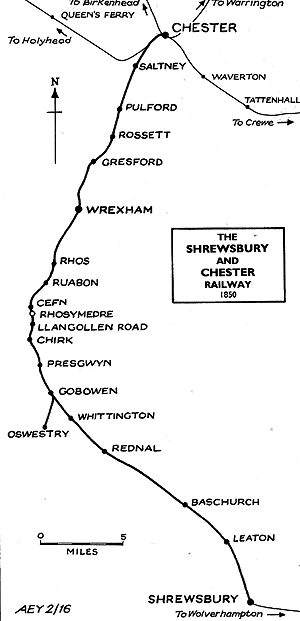 When an independent group of similar investors was formed, a Private Act of Parliament was authorised for the construction of the Shrewsbury, Oswestry & Chester Junction Railway, which was passed in 1845. Initially the proposal was to build a completely new line from a junction south-east of Chester which would cross the River Dee near Farndon, completely bypassing the North Wales Mineral Railway between Wrexham and Chester. The route would go through Overton-on-Dee and cross the Dee again near Chirk before reaching Oswestry and then heading for Shrewsbury. When an independent group of similar investors was formed, a Private Act of Parliament was authorised for the construction of the Shrewsbury, Oswestry & Chester Junction Railway, which was passed in 1845. Initially the proposal was to build a completely new line from a junction south-east of Chester which would cross the River Dee near Farndon, completely bypassing the North Wales Mineral Railway between Wrexham and Chester. The route would go through Overton-on-Dee and cross the Dee again near Chirk before reaching Oswestry and then heading for Shrewsbury.
On 27 July 1846 the North Wales Mineral Railway merged with the Shrewsbury, Oswestry & Chester Junction Railway to form the Shrewsbury & Chester Railway. Extensions were authorised: Leaton to Wem, Gobowen via Oswestry, to a proposed Shropshire union branch at Crickheath, and into the centre of Shrewsbury. With the formation of the new company the plans were immediately revised, and the construction of a new line and junction south-east from Chester was abandoned. The new company would need to build only a 30-mile line between Shrewsbury and the North Wales Mineral line at Wrexham. Work on the northern portion, from Ruabon to Chester, was rapidly pressed forward. A section of the line between Chester and Rhosymedre was opened to the public on 4 November 1846.
On 24 May 1847, five passengers were killed and many were injured in the Dee bridge disaster. A Chester to Ruabon train fell 36ft into the River Dee following the collapse of the Dee Railway bridge on the outskirts of Chester. A girder, which had cracked in the middle, gave way as the train crossed. The engine and tender managed to reach the other side of the bridge but the carriages crashed into the river. The bridge had been engineered by Robert Stephenson and constructed with cast iron girders, despite warnings from civil engineer William Fairbairn about the problems associated with this material. A Royal Commission following the accident led to a re-evaluation of the use of cast iron in railway bridges. Many new bridges had to be reinforced or rebuilt.
When construction was completed by 1848, the final route also bypassed Oswestry (one of the scheme's original destinations). Instead the town would be served by a branch line between a station in the town and Gobowen.
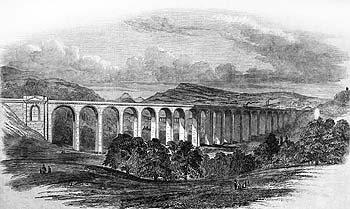 The line had two major engineering features: the Dee and Chirk viaducts. The line had two major engineering features: the Dee and Chirk viaducts.
The Dee viaduct had 19 arches, was 503yd long and was 148ft high at the point where it crossed the River Dee. Each arch had a span of 60ft and the cost of the structure was £72,346. It took two years and six months to complete, the last stone being laid on 25 August 1848. On that day a special train was run from Chester with invited guests. It stopped on the viaduct and the guests alighted. The viaduct was decorated with flags to mark the event and a band struck up ‘God Save the Queen’. The stone was then affixed, to much cheering.
The Chirk Viaduct had 10 stone arches of 45ft span. At each end there was a wooden span of 120ft. The overall length of the viaduct was 284yd. It was 100 feet high at its midpoint. The timber spans were replaced by three further arches at each end (making 16 in total) in 1858.
Both viaducts were designed by the Scottish engineer Henry Robertson.
On 12 October 1848, the extension opened to a temporary terminus at Shrewsbury, and a special train of 59 carriages, hauled by three locomotives, left Chester carrying all the dignitaries. The line was opened throughout to the public on the 14 October 1848. The average cost of the line, exclusive of the share of the joint stations at Chester and Shrewsbury and of the extensive wharfs and railways at the river Dee, amounted to £17,260 per mile.
Two Acts of 9 July 1847 authorised the S&C and CHR (Chester & Holyhead Railway) to construct a station at Chester. This would be jointly managed with the LNWR and the Birkenhead Lancashire & Cheshire Junction Railway (BL&CJ). The joint station, designed by Frances Thompson and constructed by Thomas Brassey, opened on 1 August 1848.
The London & Birmingham Railway had supported the S&C as a useful alternative route to thwart the Grand Junction Railway, and provide a potentially rival route between Birmingham, Chester, and Birkenhead, but the newly formed and larger London & North Western Railway (LNWR) began aggressively trying to take business from the line in order to put it into bankruptcy. The S&C, and Shrewsbury & Birmingham (S&B) railways were subsequently fought over by the Great Western Railway (GWR) wanting access to Merseyside, and the LNWR trying to prevent it.
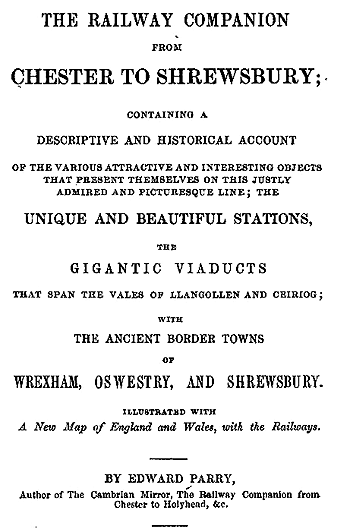 The two small companies (S&C and S&B) had hoped to develop traffic independently between Merseyside, the Black Country, and South Wales, so they made a traffic agreement with the BL&CJ. This was a challenge to the LNWR, between Wolverhampton and Birkenhead, and was also an effort to prevent them being taken over by the company. In October 1849 the LNWR gave the S&C an ultimatum, which was rejected. What followed was that the Chester Station Joint Committee, dominated by the LNWR, banned the booking of Wolverhampton passengers via Shrewsbury. Remonstrations soon followed, and the S&C’s Chester booking clerk was thrown out of his office. The two small companies (S&C and S&B) had hoped to develop traffic independently between Merseyside, the Black Country, and South Wales, so they made a traffic agreement with the BL&CJ. This was a challenge to the LNWR, between Wolverhampton and Birkenhead, and was also an effort to prevent them being taken over by the company. In October 1849 the LNWR gave the S&C an ultimatum, which was rejected. What followed was that the Chester Station Joint Committee, dominated by the LNWR, banned the booking of Wolverhampton passengers via Shrewsbury. Remonstrations soon followed, and the S&C’s Chester booking clerk was thrown out of his office.
The BL&CJ felt intimidated by this heavy-handed approach, and tried to deter S&C third class passengers by operating connections at ungodly hours. To overcome the problem, the S&C operated omnibuses to Birkenhead, but these were barred from Chester station yard by gangs of LNWR thugs, who also defaced and destroyed S&C timetables and posters.
Although an injunction stopped most of this behaviour, the problems between the companies did not go away. The LNWR consigned local Welsh and Shropshire traffic by road or canal to combat an S&C attempt to use the Dee into Chester for freight, and the BL&CJ was ‘persuaded’ to re-route its southbound traffic via the LNWR. Euston (the LNWR headquarters) also started to undercut the S&C. In desperation, the two Shrewsbury companies signed a traffic agreement with Paddington (the GWR headquarters) in 1851. After subsequent heavy-handed actions by the LNWR, which included an illegal agreement with an unauthorised second board of the S&C, the S&C agreed an on amalgamation with the GWR, (the ‘Associated Companies’), although the Bill was rejected by the House of Lords. In 1852, a joint S&B and S&C management committee was extended to include the GWR.
In 1851 the BL&CJ had offered a lease to the ‘Associated Companies’ in anticipation of their successful amalgamation; however this was postponed when the Bill was rejected. Their chairman, James Bancroft, even proposed a lease to Euston instead, and increased tolls from the S&C. A court action followed, and from December 1853 S&C Birkenhead trains were withdrawn, forcing Bancroft to buy locomotives to work S&C traffic. During the same year the GWR was seeking to lay broad gauge track between Wolverhampton and Birkenhead but was unsuccessful in getting approval.
In 1854 the amalgamation of the ‘Associated Companies’ finally took place, and the GWR also took possession of its first standard gauge locomotives. From 2 February 1856 a GWR Birkenhead goods service was started. Iron ore was sent via Shrewsbury and Hereford to South Wales in exchange for steam coal to Birkenhead, and a GWR Birmingham to Birkenhead passenger service commenced on 1 May 1857. |

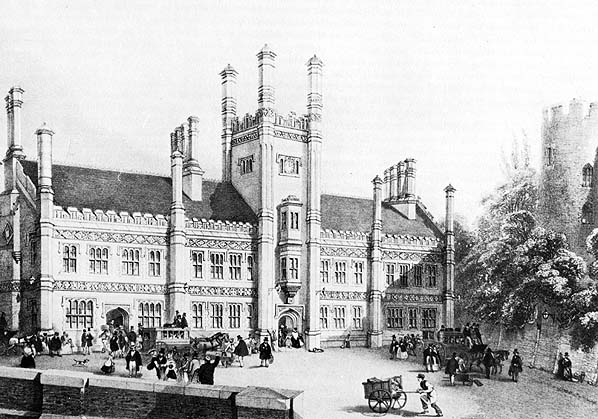
 Chirk Viaduct was one of the 'great works' of the Shrewsbury & Chester Railway. In this view from 1848 it is seen looking east from the Holyhead Road. Beyond the viaduct the Llangollen Canal Chirk aqueduct can be seen.
Chirk Viaduct was one of the 'great works' of the Shrewsbury & Chester Railway. In this view from 1848 it is seen looking east from the Holyhead Road. Beyond the viaduct the Llangollen Canal Chirk aqueduct can be seen.  When an independent group of similar investors was formed, a Private Act of Parliament was authorised for the construction of the Shrewsbury, Oswestry & Chester Junction Railway, which was passed in 1845. Initially the proposal was to build a completely new line from a junction south-east of Chester which would cross the River Dee near Farndon, completely bypassing the North Wales Mineral Railway between Wrexham and Chester. The route would go through Overton-on-Dee and cross the Dee again near Chirk before reaching Oswestry and then heading for Shrewsbury.
When an independent group of similar investors was formed, a Private Act of Parliament was authorised for the construction of the Shrewsbury, Oswestry & Chester Junction Railway, which was passed in 1845. Initially the proposal was to build a completely new line from a junction south-east of Chester which would cross the River Dee near Farndon, completely bypassing the North Wales Mineral Railway between Wrexham and Chester. The route would go through Overton-on-Dee and cross the Dee again near Chirk before reaching Oswestry and then heading for Shrewsbury. The line had two major engineering features: the Dee and Chirk viaducts.
The line had two major engineering features: the Dee and Chirk viaducts. 
 The two small companies (S&C and S&B) had hoped to develop traffic independently between Merseyside, the Black Country, and South Wales, so they made a traffic agreement with the BL&CJ. This was a challenge to the LNWR, between Wolverhampton and Birkenhead, and was also an effort to prevent them being taken over by the company. In October 1849 the LNWR gave the S&C an ultimatum, which was rejected. What followed was that the Chester Station Joint Committee, dominated by the LNWR, banned the booking of Wolverhampton passengers via Shrewsbury. Remonstrations soon followed, and the S&C’s Chester booking clerk was thrown out of his office.
The two small companies (S&C and S&B) had hoped to develop traffic independently between Merseyside, the Black Country, and South Wales, so they made a traffic agreement with the BL&CJ. This was a challenge to the LNWR, between Wolverhampton and Birkenhead, and was also an effort to prevent them being taken over by the company. In October 1849 the LNWR gave the S&C an ultimatum, which was rejected. What followed was that the Chester Station Joint Committee, dominated by the LNWR, banned the booking of Wolverhampton passengers via Shrewsbury. Remonstrations soon followed, and the S&C’s Chester booking clerk was thrown out of his office.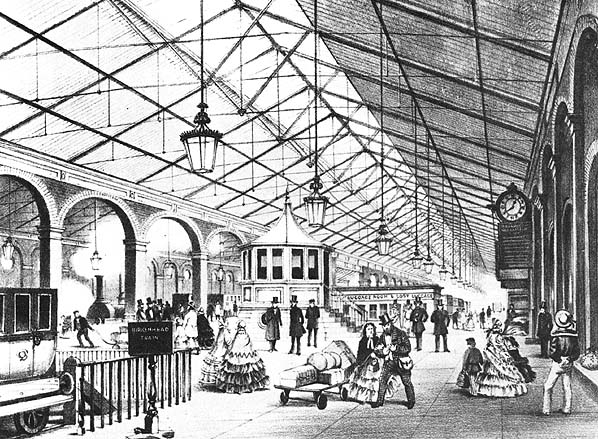 The northern terminus of the Shrewsbury & Chester Railway at Chester was also a joint station. Chester was owned by the Shrewsbury & Chester and the Chester & Holyhead Railway. This illustration shows the interior of the station looking east in the 1860s. Shrewsbury trains would have departed from the platforms to the left.
The northern terminus of the Shrewsbury & Chester Railway at Chester was also a joint station. Chester was owned by the Shrewsbury & Chester and the Chester & Holyhead Railway. This illustration shows the interior of the station looking east in the 1860s. Shrewsbury trains would have departed from the platforms to the left.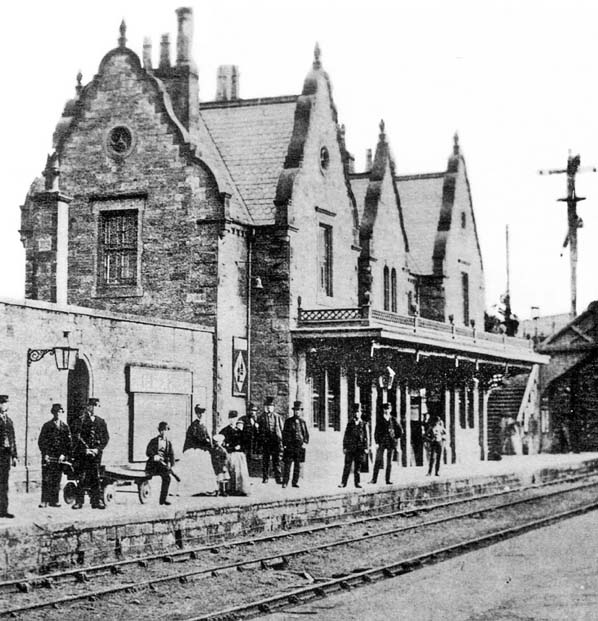 The Shrewsbury & Chester Railway station at Chester seen in the 1866 when it was part of the GWR. The station was demolished between 1910 and 1912 and was replaced by a much larger facility.
The Shrewsbury & Chester Railway station at Chester seen in the 1866 when it was part of the GWR. The station was demolished between 1910 and 1912 and was replaced by a much larger facility.
 Home Page
Home Page